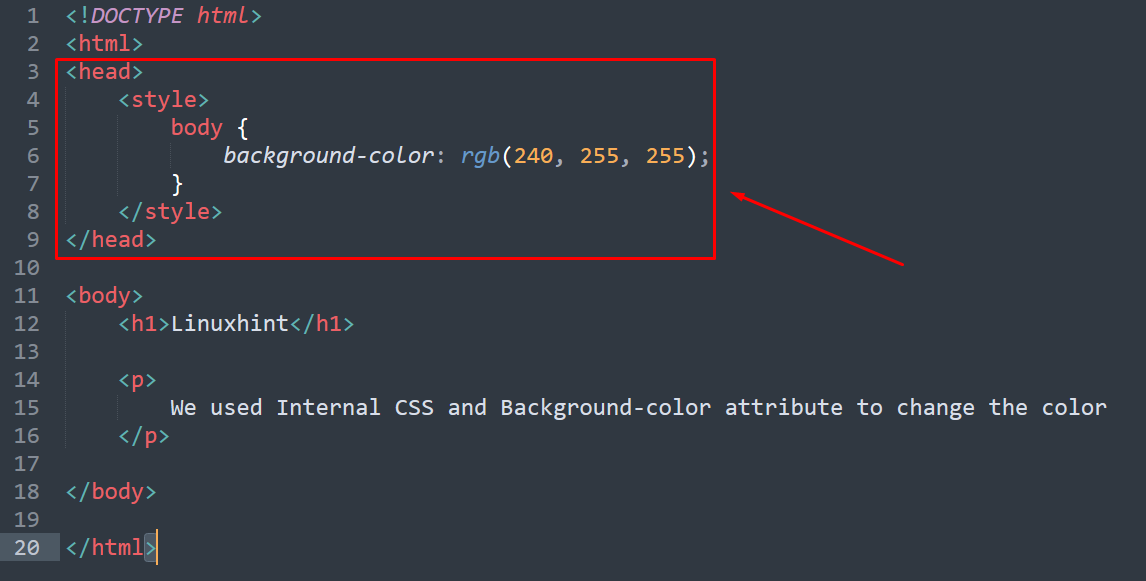Have you ever looked at a website and thought, “Wow, I wish my website looked this cool?” Maybe you’ve wanted to add a splash of color to your webpage, but you weren’t sure how. Well, you’re in luck! Today, we’re going to explore the simple yet powerful world of changing background colors in HTML. This seemingly small change can have a huge impact on the look and feel of your website, making it more visually appealing and engaging. Get ready to unleash your creativity and make your website truly your own!

Image: www.linuxconsultant.org
Imagine building a website like constructing a house. You start with the foundation (HTML structure), then add the walls and roof (CSS styling). The background color is like painting the walls – it establishes the base upon which you build the rest of your website. By understanding how to change the background color, you are taking control of the visual identity of your online space. Let’s dive in!
Changing the Background Color in HTML: A Beginner’s Guide
The magic of changing the background color lies in a simple line of CSS code. CSS, which stands for Cascading Style Sheets, is the language used to describe the style of your website, influencing everything from colors and fonts to layout and animations.
To change the background color, you’ll use the background-color property within a CSS rule. This rule specifies which element on your webpage you want to apply the color to. Here’s a basic example:
<!DOCTYPE html>
<html>
<head>
<style>
body
background-color: lightblue;
</style>
</head>
<body>
<h1>This is a Heading</h1>
<p>This is some text.</p>
</body>
</html>In this code snippet, we’ve targeted the body element, which represents the main content area of your webpage. Within the style tag, we’ve set the background-color property to lightblue. This will create a light blue canvas for all the content within your webpage.
Adding Color to Your Website: A Variety of Options
But lightblue is just the tip of the iceberg. HTML offers a vast spectrum of colours at your fingertips. You can use colour names, hexadecimal codes, or RGB values to bring your vision to life.
1. Color Names: These are simple, descriptive names like red, green, blue, yellow, and black. They are easy to remember and use.
2. Hexadecimal Codes: These are six-digit codes that represent a specific color shade. Each code uses a combination of numbers and letters (0-9, A-F). For example, #FF0000 represents the colour red, #00FF00 represents green, and #0000FF represents blue. There are countless shades of every color available through hexadecimal codes, allowing for precise customization.
3. RGB Values: These use three numbers from 0 to 255 to specify the intensity of red, green, and blue components individually. For example, rgb(255, 0, 0) is equivalent to #FF0000 (red). This format gives you even more granular control over your colors.
Example Using Hexadecimal Code
<!DOCTYPE html>
<html>
<head>
<style>
body
background-color: #FFC0CB; /* Light pink color */
</style>
</head>
<body>
<h1>This page has a pink background!</h1>
<p>Look at that beautiful color!</p>
</body>
</html>Beyond the Canvas: Applying Background Colors Selectively
You’re not limited to just changing the background color of the entire page. You can be more specific and change the background color of individual elements, such as headings, paragraphs, or even divs. This allows you to create visually appealing sections within your website.
Example of Applying Background Colors to Specific Elements:
<!DOCTYPE html>
<html>
<head>
<style>
h1
background-color: #FFA500; /* Orange */
p
background-color: #F0FFFF; /* Azure */
</style>
</head>
<body>
<h1>This heading has an orange background.</h1>
<p>This paragraph has an azure background.</p>
</body>
</html>

Image: www.stechies.com
Advanced Techniques: Gradients, Images, and More
For even more creative flair, HTML offers more advanced techniques for customizing background appearances.
1. Gradients: Instead of a solid color, you can use gradients to create smooth transitions between two or more colors. This adds depth and visual interest to your webpage.
2. Images: You can even use images as background patterns, adding a unique and visually engaging element to your webpage.
Example of Using a Gradient:
<!DOCTYPE html>
<html>
<head>
<style>
body
background-image: linear-gradient(to right, #FF0000, #FFFF00); /* Gradient from red to yellow */
</style>
</head>
<body>
<h1>This page has a gradient background!</h1>
<p>Look at that smooth transition between colors.</p>
</body>
</html>Choosing The Right Color: Tips from Design Experts
When selecting your background color, consider these tips from design experts:
- Contrast: Ensure there is sufficient contrast between your text color and background color so your text is easily readable.
- Color Psychology: Different colors evoke different emotions. Choose colors that align with the overall tone and message of your website.
- Brand Identity: Use colors that are consistent with your brand’s identity and logo.
How To Change The Background Color In Html
Conclusion: Unlocking the Power of Color
Changing background colors in HTML is a powerful tool that empowers you to personalize your website and create a visually appealing experience for your visitors. By understanding color names, hexadecimal codes, RGB values, and advanced background techniques, you can add depth and originality to your website. So go ahead, experiment, and unleash your creativity! The online world is waiting for your artistic touch.






